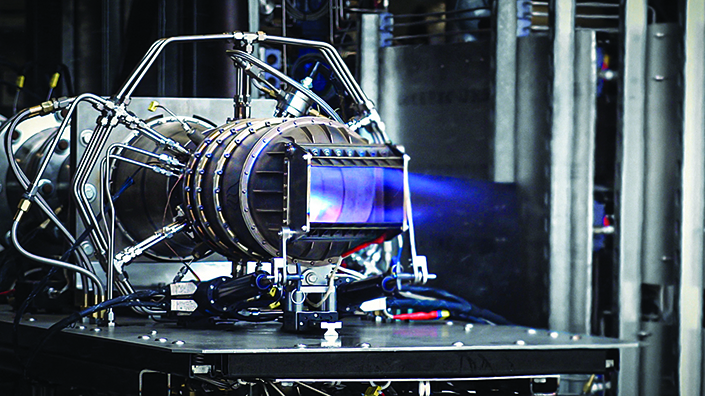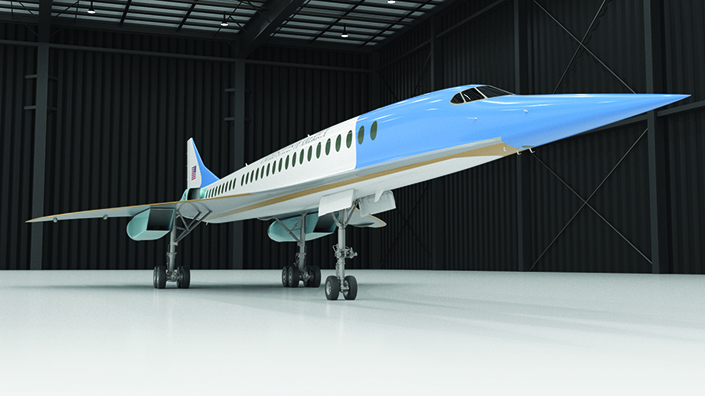Articles
In September last year, the directorate – responsible for the president’s Air Force One aircraft – signed contracts with three firms to develop supersonic executive transport. Each of the three projects could revolutionise the president’s ability to respond to events at speed.
The three US companies are:
- Exosonic. The manufacturer is integrating ‘boom softening’ techniques into its supersonic aircraft. The features aim to turn loud sonic booms into a series of softer thumps.
- Hermeus. The firm won the Air Force contract following successful testing of its Mach 5 engine prototype. It is the only one of the three pursuing hypersonic flight, using its own pre-cooler technology and a turbine-based combined-cycle engine architecture.
- Boom Supersonic. Having recently agreed a purchase agreement with United Airlines for 15 Overture airliners, Boom’s project is perhaps the most advanced of the three. The firm aims to fly the Overture – which could be configured for Air Force use – using 100% sustainable aviation fuel (SAF).

Hermeus has tested a Mach 5 engine (Credit: Hermeus)
Low boom
As with Boom, Exosonic is developing its aircraft for joint commercial and presidential applications. The firm has optimised flexibility and available cabin space within the slender fuselage, said CEO Norris Tie, so the Air Force can buy a “cleaned up” version with room for its specialised equipment. Objectives for the interior include a secure teleconferencing room with a TV and a video camera, a meeting room, general seating and a dedicated office for the president or vice-president.
Since the contract signing in September last year, Exosonic has carried out wind-tunnel testing and hired ‘low boom’ experts to help reduce the noise from supersonic flight. Loud sonic booms have seen supersonic flight banned over land in many countries, making journey times significantly longer.
The project takes inspiration from NASA’s experimental X-59 Quiet Supersonic Flight Over Land (Quesst) aircraft, which aims to cut noise over land with a strikingly long, thin nose.
“We’re using those same techniques to design our low-boom supersonic airliner, so that we can meet a predicted future noise threshold that the public will accept,” said Tie.
The Exosonic aircraft’s long, shaped nose should help distribute shockwaves, turning one loud sonic boom into a series of smaller, weaker booms. The rest of the plane is designed with the same goal in mind.
“It’s not only the nose,” said Tie. “It’s literally the entire fuselage, from the engine placement to the shape of the wings, to the shape of the tail, the fuselage, cross-section over the length of the vehicle, all those things play into it.”
Politics at the speed of sound
The main challenges for the projects will be environmental and, by extension, social, said IMechE fellow Guy Gratton, associate professor of aviation and the environment at Cranfield University. Burning fossil fuels will become increasingly unacceptable in the decades to come, and there is greater understanding of all forms of pollution – including noise.

The Overture from Boom Supersonic could fly with sustainable fuel (Credit: Boom Supersonic)
The best standards for SAFs assume 40% of the carbon footprint of conventional fuels, he said, but supersonic flight burns roughly double the fuel per passenger mile. The result for supersonic flight using SAFs could be just a 20% reduction in carbon footprint, he said.
“To a certain extent, there will still be a sonic boom, there will still be a carbon footprint,” he said. “And actually, we’re increasingly becoming aware that the major contribution of aviation to climate change isn’t our CO2 emissions, it’s contrails. And we’ve got no hard evidence that sustainable fuel will change that.”
Each of the three projects has laudable aims and the engineering expertise to achieve them. When it’s time for the Air Force to make a decision, Gratton suggests, it will most likely come down to politics rather than engineering.
Want the best engineering stories delivered straight to your inbox? The Professional Engineering newsletter gives you vital updates on the most cutting-edge engineering and exciting new job opportunities. To sign up, click here.
Content published by Professional Engineering does not necessarily represent the views of the Institution of Mechanical Engineers.